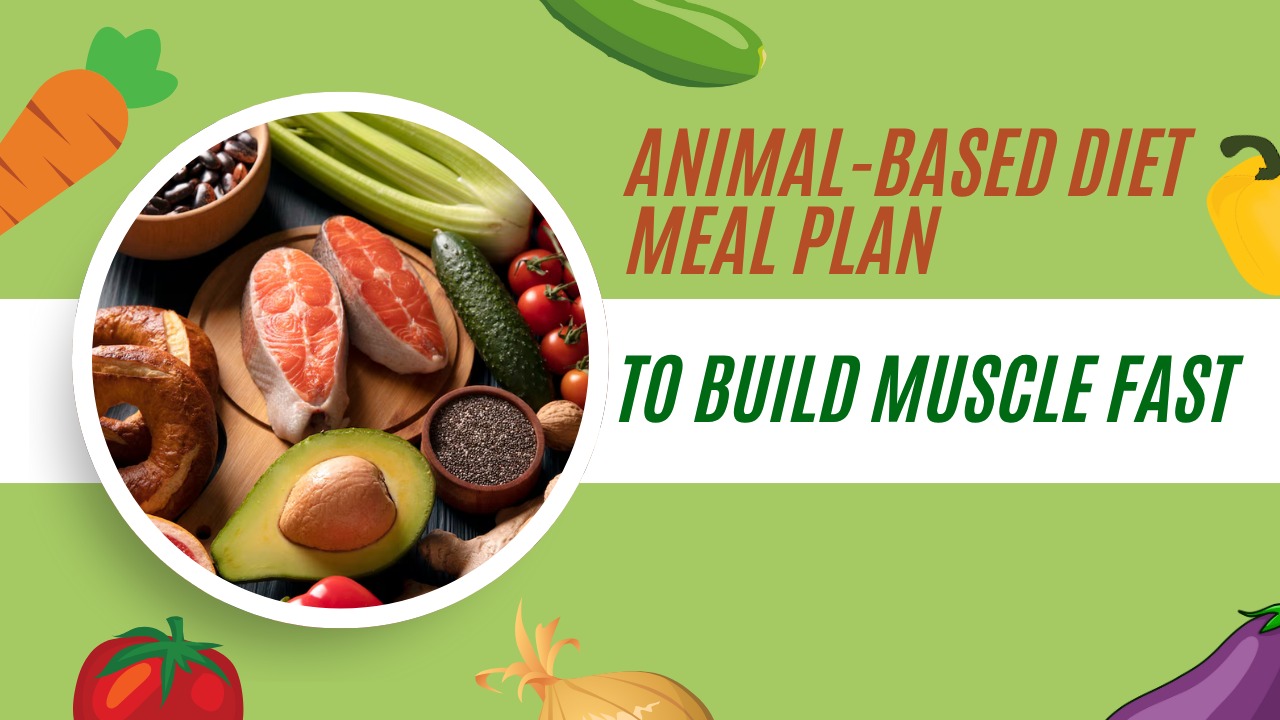The animal-based diet meal plan emphasizes consuming primarily animal-derived foods like meat, fish, eggs, and organ meats. Popularly known as the carnivore or meat-centric diet, it eliminates or drastically reduces plant-based foods. This approach appeals to those seeking better digestion, mental clarity, stable blood sugar, and simplified eating patterns.
While some followers go strict—adopting a zero-carb, all-meat lifestyle—others take a more inclusive “nose-to-tail” approach. This means eating muscle meats, liver, heart, bone marrow, and animal fat to maximize nutrient diversity and avoid deficiencies over time. It’s rooted in ancestral eating patterns that valued the whole animal.
Many people customize the animal-based diet meal plan to suit their needs. Some include limited dairy or low-carb plant foods like avocados or herbs. This flexibility makes it sustainable for those easing into the lifestyle. Whether strict or modified, this diet centers on nutrient-dense animal foods to support strength, energy, and overall wellness.

What Is an Animal‑Based Diet Meal Plan ?
An animal‑based meal plan is structured around three guiding principles:
Foundation of Animal Foods: Choose high-quality meats (beef, pork, lamb, game), fatty or oily fish (salmon, mackerel), eggs, organ meats, bone broth, and animal fats. The emphasis is on nutrient density and bioavailable protein and fat.
Minimal to No Plant Foods: Garden produce, grains, legumes, nuts, seeds, and refined carbs are either excluded altogether or kept to occasional indulgence (e.g., berries, herbs).
Balance of Fats and Protein: A traditional balance is 60–80% calories from animal fat, 20–40% from protein. This macronutrient ratio supports satiety, energy, and metabolic flexibility.
Within this framework, you can customize caloric intake, meal frequency, and food variety according to your goals (weight loss, maintenance, athletic performance, therapeutic use, etc.).
How to Build an Animal‑Based Meal Plan
Choose Your Animal Foods
Muscle meat: Beef ribeye, pork chops, ground lamb, venison
Fatty fish: Salmon, sardines
Eggs: whole eggs, pastured if possible
Organs: liver, heart, kidney
Bone broth/bone-in meats for collagen and minerals
Prioritize Fat for Energy: Animal fat provides the bulk of calories. Marbled cuts and added fat (tallow, lard, butter) help maintain energy, especially with low carbs.
Include Organs & Connective Tissue: To avoid nutrient gaps and support long-term health, add organs and collagen-rich cuts weekly.
Plan Meal Frequency: Many follow two meals/day with intermittent fasting patterns (e.g., 16:8). Others may eat three or more smaller meals depending on appetite.
Track Macronutrients (If Necessary): If you have performance goals, track protein intake (0.7–1 g per lb bodyweight) and fat to adjust calories.
Stay Hydrated & Replace Electrolytes: Low-carb intake reduces insulin and leads to sodium loss; include salt and consider magnesium, potassium supplements if needed.
When to Eat: Timing & Frequency
Traditional Breakfast: Lunch-Dinner works well if you train or break fast in the morning.
Time-Restricted Eating (TRE): 16-hour fasting, 8-hour food window can promote metabolic health.
Post-Workout Nutrition: Focus on high-quality protein and fat after resistance or endurance sessions.
Listening to Hunger Signals: Many recommend intuitive eating—only eat when hungry, stop when satiated.
Why People Choose an Animal‑Based Approach
Simplicity & Satiety: No need to calorie-count or balance meals—animal foods tend to fill you up naturally.
Digestive Relief: Many people with IBS, bloating, or food sensitivities report relief with plant exclusion.
Potential Blood Marker Improvements: Anecdotes and some evidence show reductions in blood sugar, triglycerides, and inflammation.
Reduction in Inflammatory Compounds: Excluding lectins, oxalates, fiber may help those with autoimmune or inflammatory issues.
Mental Clarity & Energy Stability: Stable blood sugar and high-fat intake may improve focus, reduce brain fog, and support mood.
Top Tips for an Effective Animal‑Based Diet Meal Plan
Prioritize Fatty, High‑Quality Cuts
When building an effective animal-based diet meal plan, focusing on fatty, nutrient-dense cuts of meat is essential. These cuts not only provide ample protein but also deliver vital fats that are crucial for hormone production, brain function, and long-lasting satiety.

Fatty cuts like ribeye steak, lamb chops, pork belly, and wild-caught salmon are rich in omega-3s, B vitamins, and fat-soluble nutrients such as vitamins A, D, and K2. These nutrients help reduce inflammation, support metabolic health, and improve nutrient absorption—making them a cornerstone of any nutrient-dense diet.
An ideal animal-based diet meal plan balances muscle meat with organ meats like liver or heart to ensure a full spectrum of amino acids and micronutrients. Choosing grass-fed, pasture-raised, or wild-sourced meats enhances the nutritional profile while minimizing exposure to additives and toxins. Prioritizing quality and fat content makes your carnivorous meals more satisfying and nutritionally complete.
Why it matters: Fat is your primary fuel—too much lean protein without matching energy can lead to fatigue, headaches, or irritability.
Benefits:
Sustained energy, richer flavor, better nutrient absorption of fat-soluble vitamins (A, D, E, K).
Ingredients to include:
Ribeye steak, pork belly, lamb shoulder, chicken thighs with skin, salmon fillets with fat, beef tallow.
Sample Meal:
Ribeye pan-seared in tallow, topped with ghee, side of bone marrow.
Include Organ Meats at Least Weekly
Including organ meats at least once a week is a powerful way to upgrade your animal-based diet meal plan. Organs like liver, heart, and kidneys are among the most nutrient-dense foods available—packed with essential vitamins, minerals, and coenzymes that muscle meat alone may lack.
Liver, for example, is rich in vitamin A, iron, B12, folate, and copper—nutrients crucial for energy, immune support, and red blood cell production. Heart provides high levels of CoQ10, which supports cardiovascular health and cellular energy. These organs are not only potent but also economical, making them a smart addition to your routine.
In a well-rounded animal-based diet meal plan, consuming organ meats ensures you’re covering a broader nutritional spectrum, especially if plant foods are minimized or eliminated. Try blending liver into ground beef, slow-cooking heart, or experimenting with pâté to make organ meats more palatable and enjoyable. Start small and build from there.
Why: Organs like liver and heart are nutritional powerhouses—rich in vitamins A, B12, heme iron, choline, CoQ10.
Benefits:
Prevents micronutrient deficiencies, supports energy, cognition, fertility, immune health.
Ingredients to include:
Beef liver, chicken hearts, pork kidneys.
Use liver pâté, eggs with chopped liver, or blend in ground meat.
Rotate Your Animal Protein Sources
To get the most nutritional value from an animal-based diet meal plan, it’s essential to rotate your sources of animal protein regularly. Sticking to just beef or chicken can limit the diversity of nutrients you’re consuming, while a varied intake ensures better coverage of amino acids, vitamins, and minerals.
Try incorporating different types of meat such as beef, lamb, pork, bison, and poultry throughout the week. Add in fish like salmon, sardines, and mackerel to boost your intake of omega-3 fatty acids and important micronutrients like selenium and iodine. Eggs are also a great source of bioavailable protein and fat-soluble vitamins.
A strategic animal-based diet meal plan should include muscle meat, fatty cuts, organ meats, and seafood for balance and variety. Rotating your proteins not only prevents nutrient gaps but also keeps meals interesting and sustainable in the long run. Variety truly is key in achieving optimal results.
Why: Diversity ensures you get a broader nutrient spectrum and avoid overloading any one protein source.
Benefits:
Exposure to varied micronutrients, reduced risk of sensitivities, culinary enjoyment.
Ingredients:
Rotate between beef, pork, lamb, turkey, bison, fish (salmon, sardines), shellfish (shrimp, oysters).
Use Bone Broth & Collagen-Rich Cuts
An effective animal-based diet meal plan goes beyond just steaks and eggs—it also includes nutrient-rich components like bone broth and collagen-rich cuts. These elements support joint health, skin elasticity, gut integrity, and overall connective tissue strength.

Bone broth, made by simmering bones, tendons, and ligaments, is packed with gelatin, amino acids (like glycine and proline), and minerals such as calcium and magnesium. Including it in your daily routine—either as a warm beverage or a base for soups—can help fill in nutritional gaps often overlooked in standard meat-heavy diets.
Collagen-rich cuts like oxtail, beef shank, chicken feet, and short ribs are highly beneficial additions to your animal-based diet meal plan. These cuts offer not only flavor and satiety but also the structural proteins your body needs to maintain optimal health. Regularly consuming these elements ensures you’re practicing a truly nose-to-tail, well-rounded dietary approach.
Why: Animal-based diets can be low in certain minerals or collagen, important for connective tissue, skin, joints, and gut lining.
Benefits:
Gelatin supports joint and skin health; bone broths replace minerals like magnesium, calcium, phosphorus.
Ingredients:
Beef/oxtail bones, simmered 12–24 hours. Collagen peptide powders.
Soup: bone broth with shredded chicken or pulled pork.
Salt Adequately and Balance Electrolytes
When following an animal-based diet meal plan, proper electrolyte balance becomes essential for sustained energy, hydration, and muscle function. Since eliminating plant foods can reduce your intake of potassium and magnesium, and the diet is naturally low in carbohydrates, you tend to lose sodium more rapidly through urine.
To counter this, it’s crucial to salt your food adequately—preferably using mineral-rich salts like Himalayan pink salt or sea salt. These options provide trace minerals that support everything from nerve signaling to fluid regulation. Don’t shy away from salting your meals to taste, especially in the early stages of transitioning to this diet.
Additionally, consider incorporating foods like bone broth for added sodium and gelatin, and supplementing with potassium and magnesium as needed. Maintaining a well-rounded electrolyte profile helps prevent fatigue, cramps, and brain fog while supporting overall wellness on your animal-based diet meal plan. It’s a small effort with a significant impact.
Why: Low carb diets increase renal sodium excretion, which may cause cramping, fatigue, or headache if not replaced.
Benefits:
Stable hydration, reduced muscle cramps, improved performance.
Ingredients:
Quality salt (sea salt, pink Himalayan salt)—1–3 tsp/day.
Consider magnesium glycinate, potassium chloride supplements.
Listen to Your Body & Adjust Macro Balance
When following an animal-based diet meal plan, there’s no one-size-fits-all approach. Your body’s needs can vary based on energy output, age, metabolic health, and goals like weight loss, muscle gain, or healing. Listening to your body’s signals is key for long-term success.

Some individuals thrive on higher fat intake, finding satiety and sustained energy with fatty cuts like ribeye, egg yolks, or beef tallow. Others may feel better with a slightly higher protein ratio, especially if they’re more active or looking to build lean mass. The right macro balance—fat to protein—may shift over time as your body adapts.
Tracking your energy, digestion, sleep, and mood can help you fine-tune your animal-based diet meal plan. Don’t hesitate to experiment with different cuts, organ meats, or bone broths to find what works best. Flexibility and mindful adjustments help you stay in tune with your body’s needs for optimal results.
Why: Some days require more protein (after heavy training), others more fat (if sedentary).
Benefits:
Supports muscle recovery, hormonal stability, weight management.
Ingredients:
Protein-rich: lean steak, chicken breast, canned fish.
Fat-rich: duck legs, fish with skin, added fat on meats, butter.
Strategic Time-Restricted Eating (TRE)
Strategic Time-Restricted Eating (TRE) is a powerful tool that pairs well with an animal-based diet meal plan. TRE involves consuming all your meals within a specific time window—often 6 to 8 hours—and fasting for the remaining hours of the day. This approach supports metabolic health, improves insulin sensitivity, and helps regulate hunger hormones naturally.
When following an animal-based diet meal plan, TRE can enhance fat-burning by giving your body longer periods without food, allowing it to tap into stored energy more efficiently. Animal-based meals, rich in fat and protein, naturally promote satiety, making it easier to go without snacking between meals or during fasting windows.
Start by delaying your first meal and having your last meal earlier in the day. Be sure each meal within your eating window is nutrient-dense—think eggs, steak, liver, or salmon. Over time, your body adapts, energy stabilizes, and cravings fade, making TRE a sustainable and effective practice.
Why: Limiting eating window may enhance weight loss, metabolic flexibility, and insulin sensitivity.
Benefits:
Fat adaptation, energy consistency, improved body composition.
Plan Example:
12–2 PM first meal (e.g., eggs & bacon + bone broth).
6–8 PM second meal (e.g., lamb chops + liver pâté).
Fast overnight until noon the next day.
Go Nose‑to‑Tail for Nutrient Density
One of the core principles of an effective animal-based diet meal plan is going nose-to-tail. This means consuming not just muscle meat, but also nutrient-rich organs, connective tissue, and bones. Each part of the animal offers a unique nutritional profile that supports whole-body health and balances the nutrients found in muscle meats alone.
Organ meats like liver, heart, and kidney are packed with essential vitamins and minerals—far more than what’s found in steak or chicken breast. Collagen-rich cuts like oxtail, skin, and bone broth help support joint, skin, and gut health. By eating nose-to-tail, you mimic ancestral eating patterns and maximize nutritional intake from animal foods.
Incorporating variety within your animal-based diet meal plan helps avoid nutrient imbalances and enhances long-term sustainability. Even eating organ meats once or twice a week can make a big impact on energy, immunity, and recovery—making this practice a cornerstone of optimal health.
Why: Incorporating connective tissue, organ, and fat protects against imbalances and supports long-term health.
Benefits:
Collagen (skin/hair/gut health), storable vitamins (A, D), trace minerals, CoQ10, taurine, carnosine.
Ingredients:
Beef heart, oxtail, tripe, tongue, bone marrow.
Make meat-heavy stews, pâtés, slow‑roasts, or simply grill.
Sample 7‑Day Meal Plan
Here is your meal schedule formatted in a table with the keyword animal-based diet meal plan included:
Animal-Based Diet Meal Plan: Weekly Schedule
| Day | Meal 1 (Noon) | Meal 2 (6–7 PM) |
|---|---|---|
| Mon | 3 eggs + 3 bacon, bone broth | Ribeye steak + marrow butter |
| Tue | Salmon + 2 tbsp tallow, bone broth | Lamb shoulder roast with collagen broth |
| Wed | Ground beef patties + organ mix (¼ liver), broth | Chicken thighs + bone marrow broth |
| Thu | Beef heart steak + eggs, broth | Pork belly + liver pâté |
| Fri | Sardines + eggs, broth | Grilled ribeye + bone broth |
| Sat | Organ meat breakfast hash (kidney + heart), broth | Venison tenderloin + marrow butter |
| Sun | Omelette with beef liver + bone broth | Bone-in short ribs + broth-based sauce |
Note: Eat when hungry and rest 12–16 hours between dinner and the next day’s first meal. This structured animal-based diet meal plan supports nutrient density and metabolic balance.
Tips for Phasing Into the Diet
Ease in Gradually:Replace carbs with fats over 1–2 weeks to mitigate “keto flu.”
Example: Swap a carb-based meal for eggs & bacon.
Manage Flow & Electrolytes: Expect increased urination and sodium loss. Salt well, drink when thirsty.
Use Digestive Support if Needed: Digestive enzymes or bile salts may help initially with higher fat digestion.
Keep Simple Foods Handy: Hard‑boiled eggs, canned sardines, grass‑fed jerky for travel or convenience.
Track Key Markers: Monitor energy, mood, sleep, digestion, body comp, and blood lipids or markers as needed.
Re-feed Carbs If Necessary: Occasional safe starches (yams, white rice) may help individuals with sustained athletic demands or female hormone health.
Potential Benefits & Challenges
✅ Benefits
Satiety & Weight Management: High fat and protein keep hunger at bay.
Less Digestive Distress: Many report reduced bloating, gas, IBS symptoms.
Blood Metrics: Triglycerides, HDL often improve; blood sugar stabilizes.
Mental Clarity: Steady fuel may support sustained focus.
Skin, Joint, Gut Support: Collagen and gelatin from bones help structural health.
⚠️ Challenges
Social & Practical Limitations: Harder to follow at restaurants or gatherings.
Micronutrient Gaps: Risk of vitamin C, fiber, antioxidants unless organs are consumed.
High in Saturated Fat: Though many argue this isn’t harmful, those with certain genetics or LDL patterns may need to monitor lipids.
Fiber / Bowel Regularity: Some experience constipation—resolve with hydration, broths, magnesium, or fermented plant foods if tolerated.
Conclusion
An animal-based diet meal plan offers a simplified and nutrient-dense approach to eating that emphasizes whole, minimally processed animal foods. By focusing on high-quality meats, organ meats, collagen-rich cuts, and healthy animal fats, this plan supports satiety, muscle maintenance, and essential nutrient intake with fewer variables than mixed diets.

For those seeking better digestion, fewer cravings, and steady energy, an animal-based diet meal plan can be a transformative tool. Many individuals report improvements in inflammation, skin health, and mental clarity when plant-based irritants are minimized or removed. Including bone broth and organ meats ensures optimal levels of vitamins, minerals, and amino acids.
Like any nutritional strategy, success with an animal-based diet meal plan depends on listening to your body, adjusting macros as needed, and ensuring adequate hydration and electrolytes. Whether used short-term for healing or as a long-term lifestyle, it can be a powerful foundation for health and performance.
FAQs
Q1. What is an animal-based diet meal plan ?
An animal-based diet meal plan primarily consists of animal-derived foods such as meat, fish, eggs, and organ meats. It eliminates or severely limits plant-based foods like grains, legumes, fruits, and vegetables. Some versions include dairy or small amounts of low-carb plants. This approach focuses on nutrient density, satiety, and reduced inflammation, often using a nose-to-tail strategy to provide a full spectrum of vitamins and minerals.
Q2. Is an animal-based diet meal plan healthy long term ?
Yes, many individuals thrive long term on an animal-based diet meal plan when it’s properly structured. Including organ meats, bone broth, fatty cuts, and rotating protein sources helps prevent nutrient deficiencies. Monitoring electrolytes, hydration, and digestion is also important. However, it’s best to consult with a healthcare professional, especially if you have underlying conditions.
Q3. Can you lose weight on an animal-based diet meal plan ?
Absolutely. Many people experience weight loss on an animal-based diet meal plan due to increased protein and fat intake, which promotes satiety and reduces overeating. The absence of processed carbohydrates and sugars helps regulate blood sugar and insulin levels, often resulting in steady fat loss without tracking calories.
Q4. How do I start an animal-based diet meal plan ?
Begin with simple meals using fatty cuts of meat like ribeye, ground beef, or salmon. Include eggs and organ meats weekly. Bone broth is excellent for gut health. Keep hydration and electrolytes in check. Gradually eliminate plant foods and observe how your body responds. The key to success on an animal-based diet meal plan is consistency and listening to your body’s signals.
Q5. Is fiber a concern on an animal-based diet meal plan ?
Not necessarily. While the animal-based diet meal plan is low in fiber, many people report improved digestion and regularity without it. This is because irritants from plants are removed, reducing inflammation in the gut. However, if digestive issues arise, adding fermented foods or transitioning slowly can help.


